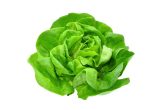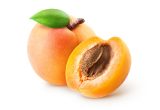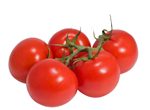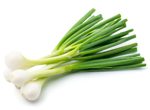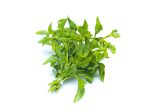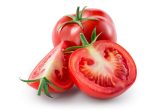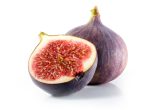Gooseberry

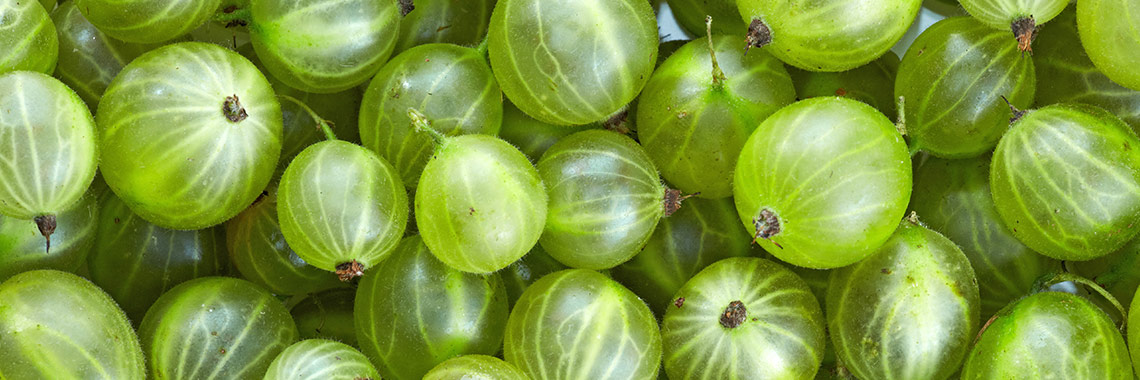
Description
- Gooseberry (Ribes uva-crispa L.) belongs to the Grossulariaceae family.
PHYSICAL AND ORGANOLEPTIC CHARACTERISTICS
- The weight of the fruit varies from 1.5 g to over 12 g, the average is about 3-6 g (Pluta, 2018).
- The colour of the berries can vary from green to yellow-green, yellow or white, pink, red, dark red or purple (Pluta, 2018).
- The taste ranges from very tart to very sweet (Pluta, 2018).
- Gooseberry consists of volatile compounds such as (Z)-hex-3-enal, (E)-hex-2-enal (C6 compounds), derivatives of lipid oxidation and short chain esters (ethyl acetate, methyl butanoate, ethyl butanoate), which are the main components identified in the fresh fruit (Hempfling, 2013).
- Short chain esters and C6 compounds are mainly responsible for the characteristic green and fruity taste of gooseberries (Hempfling, 2013).
COMPOSITION CHARACTERISTICS (excluding macronutrients, vitamins and minerals)
- 4 gooseberry (Ribes uva-crispa L.) cultivars Invicta, Rixanta, Karat and Black Negus and 5 currant (Ribes) cultivars NS 11, Focus, Ben Gairn, Otelo and Viola, were evaluated as potential sources of bioactivity1 after determining their total phenol, flavonoid and anthocyanin contents (Orsavova, 2019).
- A variety of polyphenols were detected in the skin and flesh of 20 gooseberry cultivars, representing mainly flavonol glycosides, anthocyanins and flavan-3-ols. On the other hand, gooseberry seeds were for the first time characterised by the presence of considerable amounts of hydroxycinnamic acid glycosides (Anastasiadi, 2016).
- All the cultivars examined represented a good source of vitamin C while being low in sugar. Moreover, the overall quality of the berries, as well as that of their bioactive compounds, remained stable for two weeks post-harvest (Anastasiadi, 2016).
1 Biological activity beneficial to health
RAW
The following values are approximate and depend on variety, season, ripeness, cultivation conditions, etc.
Gooseberries are low in energy* as they provide an average of 39.90 calories (kcal) per 100 g, i.e. 167 kJ.
COMPOSITION TABLES
For each nutrient, the tables provide information on the content, the minimum and maximum values, as well as the percentage of the Dietary Reference Values (DRVs) for 100 g net of raw gooseberries.
*Regulation (EC) No 1924/2006 of the European Parliament and of the Council of 20 December 2006 on nutrition and health claims made on foods.
MACRONUTRIENTS
| Constituent (g) | Average content |
Min-Max per 100g |
DRV% |
|---|---|---|---|
| Water | 87,9 | 83 - 92,80 | - |
| Fibers | 4,03 | 1,90 - 4,30 | - |
| Carbohydrates | 4,88 | - | 1,88 |
| Sugars | - | - | - |
| Lipids | 0,59 | 0,40 - 0,70 | 0,84 |
| Saturated fat | 0,058 | 0,038 - 0,078 | 0,29 |
| Protein | 0,75 | 0,10 - 1,25 | 1,50 |
| Constituent (g) | Amount | Min-Max | DRV% |
|---|---|---|---|
| Water | Ciqual 2020 | - | - |
| Fibers | Ciqual 2020 | - | - |
| Carbohydrates | Ciqual 2020 | - | Règlement (UE) N°1169/2011 du parlement Européen, et du conseil du 25 octobre 2011 |
| Sugars | Ciqual 2020 | - | Règlement (UE) N°1169/2011 du parlement Européen et du conseil du 25 octobre 2011 |
| Lipids | Ciqual 2020 | - | Règlement (UE) N°1169/2011 du parlement Européen et du conseil du 25 octobre 2011 |
| Saturated fat | Ciqual 2020 | - | Règlement (UE) N°1169/2011 du parlement Européen et du conseil du 25 octobre 2011 |
| Protein | Ciqual 2020 | - | Règlement (UE) N°1169/2011 du parlement Européen et du conseil du 25 octobre 2011 |
Zoom on carbohydrates
- Gooseberries contain a quantity of carbohydrates (4.88 g per 100 g) which is below the average content found in fresh fruit: approximately 11.31 g per 100 g.
- Gooseberries are low in sugar as they contain less than 5 g per 100 g.
Zoom on fibres
- Gooseberries are a source of fibre* as they contain 4.03 g per 100 g of fruit, i.e. more than 3 g per 100 g.
- They contain more than the average content found in fresh fruit (2.77 g per 100 g).
Zoom on proteins
- The protein content of gooseberries (0.75 g per 100 g) is lower than the average amount found in fresh fruit: 0.93 g per 100 g.
Zoom on lipids
- The fat content of gooseberries (0.59 g per 100 g) is almost equivalent to the average amount found in fresh fruit: 0.56 g per 100 g.
- Gooseberries are low in fat as they contain less than 3 g per 100 g.
*Regulation (EC) No 1924/2006 of the European Parliament and of the Council of 20 December 2006 on nutrition and health claims made on foods.
MINERALS AND TRACE ELEMENTS
| Constituent | Average content |
Min-Max per 100g |
DRV% |
|---|---|---|---|
| Calcium (mg) | 25,40 | 14,60 - 33 | 3,18 |
| Chloride (mg) | - | - | - |
| Copper (mg) | 0,063 | 0,054 - 0,07 | 6,30 |
| Iron (mg) | 0,33 | 0,28 - 0,54 | 2,36 |
| Iodine (µg) | 0,30 | 0,15 - 0,53 | 0,20 |
| Magnesium (mg) | 9 | 6 - 10 | 2,40 |
| Manganese (mg) | 0,16 | 0,13 - 0,19 | 8 |
| Phosphorus (mg) | 26,20 | 14,50 - 28,70 | 3,74 |
| Potassium (mg) | 187 | 171 - 198 | 9,35 |
| Selenium (µg) | 0,068 | NC - 0,40 | 0,12 |
| Sodium (mg) | 1,50 | 1 - 2,60 | - |
| Zinc (mg) | 0,14 | 0,12 - 0,16 | 1,40 |
| Constituent | Amount | Min-Max | DRV% |
|---|---|---|---|
| Calcium (mg) | Ciqual 2020 | - | Règlement (UE) N°1169/2011 du parlement Européen et du conseil du 25 octobre 2011 |
| Chloride (mg) | Ciqual 2020 | - | Règlement (UE) N°1169/2011 du parlement Européen et du conseil du 25 octobre 2011 |
| Copper (mg) | Ciqual 2020 | - | Règlement (UE) N°1169/2011 du parlement Européen et du conseil du 25 octobre 2011 |
| Iron (mg) | Ciqual 2020 | - | Règlement (UE) N°1169/2011 du parlement Européen et du conseil du 25 octobre 2011 |
| Iodine (µg) | Ciqual 2020 | - | Règlement (UE) N°1169/2011 du parlement Européen et du conseil du 25 octobre 2011 |
| Magnesium (mg) | Ciqual 2020 | - | Règlement (UE) N°1169/2011 du parlement Européen et du conseil du 25 octobre 2011 |
| Manganese (mg) | Ciqual 2020 | - | Règlement (UE) N°1169/2011 du parlement Européen et du conseil du 25 octobre 2011 |
| Phosphorus (mg) | Ciqual 2020 | - | Règlement (UE) N°1169/2011 du parlement Européen et du conseil du 25 octobre 2011 |
| Potassium (mg) | Ciqual 2020 | - | Règlement (UE) N°1169/2011 du parlement Européen et du conseil du 25 octobre 2011 |
| Selenium (µg) | Ciqual 2020 | - | Règlement (UE) N°1169/2011 du parlement Européen et du conseil du 25 octobre 2011 |
| Sodium (mg) | Ciqual 2020 | - | - |
| Zinc (mg) | Ciqual 2020 | - | Règlement (UE) N°1169/2011 du parlement Européen et du conseil du 25 octobre 2011 |
Zoom on minerals and trace elements
- Potassium is the mineral best represented in gooseberries as its content is equivalent to 9.35% of DRVs, i.e. 187 mg per 100 g.
- The other minerals and trace elements are present in quantities representing less than 9% of DRVs.
VITAMINS
| Constituent | Average content |
Min-Max per 100g |
DRV% |
|---|---|---|---|
| Provitamin A Beta-carotene (µg) | - | - | - |
| Vitamin A equivalent (µg) | - | - | - |
| Vitamin B1 (mg) | 0,033 | 0,011 - 0,04 | 3 |
| Vitamin B2 (mg) | 0,029 | 0,019 - 0,03 | 2,07 |
| Vitamin B3 (mg) | 0,29 | 0,16 - 0,35 | 1,81 |
| Vitamin B5 (mg) | 0,29 | - | 4,83 |
| Vitamin B6 (mg) | 0,048 | 0,007 - 0,08 | 3,43 |
| Vitamin B9 (µg) | 8,85 | 6 - 11,70 | 4,43 |
| Vitamin C (mg) | 29 | 18 - 56 | 36,25 |
| Vitamin E (mg) | 0,69 | 0,37 - 1,28 | 5,75 |
| Vitamin K1 (µg) | - | - | - |
| Constituent | Amount | Min-Max | DRV% |
|---|---|---|---|
| Provitamin A Beta-carotene (µg) | Ciqual 2020 | - | - |
| Vitamin A equivalent (µg) | - | - | Règlement (UE) N°1169/2011 du parlement Européen et du conseil du 25 octobre 2011 |
| Vitamin B1 (mg) | Ciqual 2020 | - | Règlement (UE) N°1169/2011 du parlement Européen et du conseil du 25 octobre 2011 |
| Vitamin B2 (mg) | Ciqual 2020 | - | Règlement (UE) N°1169/2011 du parlement Européen et du conseil du 25 octobre 2011 |
| Vitamin B3 (mg) | Ciqual 2020 | - | Règlement (UE) N°1169/2011 du parlement Européen et du conseil du 25 octobre 2011 |
| Vitamin B5 (mg) | Ciqual 2020 | - | Règlement (UE) N°1169/2011 du parlement Européen et du conseil du 25 octobre 2011 |
| Vitamin B6 (mg) | Ciqual 2020 | - | Règlement (UE) N°1169/2011 du parlement Européen et du conseil du 25 octobre 2011 |
| Vitamin B9 (µg) | Ciqual 2020 | - | Règlement (UE) N°1169/2011 du parlement Européen et du conseil du 25 octobre 2011 |
| Vitamin C (mg) | Ciqual 2020 | - | Règlement (UE) N°1169/2011 du parlement Européen et du conseil du 25 octobre 2011 |
| Vitamin E (mg) | Ciqual 2020 | - | Règlement (UE) N°1169/2011 du parlement Européen et du conseil du 25 octobre 2011 |
| Vitamin K1 (µg) | Ciqual 2020 | - | Règlement (UE) N°1169/2011 du parlement Européen et du conseil du 25 octobre 2011 |
Zoom on vitamins
- Gooseberries are high in vitamin C, as they provide the equivalent of 36.25% of DRVs, i.e. 29 mg per 100 g.
- The other vitamins are present in quantities representing less than 6% of DRVs.
POLYPHENOLS
| Constituent (mg) | Average content |
Min-Max per 100mg |
|---|---|---|
| Flavonoids (mg) | 8,67 | 2,15 - 15,92 |
| of which Flavanols (mg) | 2,11 | 2,11 - 2,11 |
| of which Anthocyanins (mg) | 6,56 | 0,04 - 13,81 |
| Phenolic Acids (mg) | 5 | 3,30 - 6,70 |
| of which Hydroxybenzoic acids (mg) | 1,60 | 1,10 - 2,10 |
| of which Hydroxycinnamic acids (mg) | 3,40 | 2,20 - 4,60 |
| Total polyphenols | 13,67 | 5,45 - 22,62 |
| Constituent (mg) | Amount | Min-Max |
|---|---|---|
| Flavonoids | Etude Phenol explorer 3,6 Méthode utilisée : Chromatographie | - |
| of which Flavanols | Etude Phenol explorer 3,6 Méthode utilisée : Chromatographie | - |
| of which Anthocyanins | Etude Phenol explorer 3,6 Méthode utilisée : Chromatographie | - |
| Phenolic Acids | Phenol explorer 3,6 Méthode utilisée : Chromatographie | - |
| of which Hydroxybenzoic acids | Phenol explorer 3,6 Méthode utilisée : Chromatographie | - |
| of which Hydroxycinnamic acids | Phenol explorer 3,6 Méthode utilisée : Chromatographie | - |
| Total polyphenols | Phenol explorer 3,6 Méthode utilisée : Chromatographie | - |
Zoom on polyphenols
- Polyphenols are substances with an antioxidant effect.
- The gooseberry has a notable quantity of polyphenols, 63% of which are flavonoids and the majority anthocyanins.
Nutrition and health claims
According to the definitions of nutrition claims as set out in Regulation (EC) No 1924/2006 on nutrition and health claims, and in view of the composition of gooseberries, the following claims may be used:
NUTRITION CLAIMS OF GOOSEBERRIES
- Low in energy (100 g of gooseberries provide less than 40 kcal)
- Low in sugar (100 g of gooseberries contain less than 5 g of sugar)
- Low in fat (100 g of gooseberries contain less than 3 g of fat)
- High in vitamin C (100 g of gooseberries provide the equivalent of more than 30% of DRVs)
- Source of fibre (100 g of gooseberries provide more than 3 g of fibre).
HEALTH CLAIMS (for a consumption of 100 g of gooseberries)
Vitamin C
- Vitamin C contributes to:
- normal function of the immune system during and after intense physical exercise,
- normal collagen formation for the normal function of blood vessels,
- normal collagen formation for the normal function of bones,
- normal collagen formation for the normal function of cartilage,
- normal collagen formation for the normal function of gums,
- normal collagen formation for the normal function of skin,
- normal collagen formation for the normal function of teeth,
- normal energy-yielding metabolism,
- normal functioning of the nervous system,
- normal psychological function,
- normal function of the immune system,
- protection of cells from oxidative stress,
- reduction of tiredness and fatigue,
- regeneration of the reduced form of vitamin E.
- Vitamin C increases iron absorption.
References
- Agence nationale de sécurité sanitaire de l’alimentation, de l’environnement et du travail. Table de composition nutritionnelle des aliments Ciqual 2020. Consultée le 24/08/2020 depuis le site internet Ciqual https://ciqual.anses.fr/
- Agence nationale de sécurité sanitaire de l’alimentation, de l’environnement et du travail. Table de composition nutritionnelle des aliments Ciqual pour le calcul des apports nutritionnels CALNUT 2020. Consultée le 21/09/2020 depuis le site internet Ciqual https://ciqual.anses.fr/
- Anastasiadi M, Mwangi PM, Ordaz-Ortiz JJ, Redfern SP, Berry M, Simmonds M, Terry LA. Tissue biochemical diversity of 20 gooseberry cultivars and the effect of ethylene supplementation on postharvest life. Postharvest Biology and Technology. 2016;117:141-51.
- Hempfling K, Fastowski O, Kopp M, Nikfardjam MP, Engel KH. Analysis and sensory evaluation of gooseberry (Ribes uva crispa L.) volatiles. J Agric Food Chem. 2013;61(26):6240-9.
- Neveu V, Perez-Jiménez J, Vos F, Crespy V, du Chaffaut L, Mennen L, Knox C, Eisner R, Cruz J, Wishart D, Scalbert A. (2010) Phenol-Explorer: an online comprehensive database on polyphenol contents in foods. Database, doi: 10.1093/database/bap024. Full text (free access)
- Orsavova J, Hlavacova I, Mlcek J, Snopek L, Misurcova L. Contribution of phenolic compounds, ascorbic acid and vitamin E to antioxidant activity of currant (Ribes L.) and gooseberry (Ribes uva-crispa L.) fruits. Food Chemistry. 2019;284:323-33.
- Pluta S. Gooseberry—Ribes uva-crispa, sin. R. grossularia L. Exotic Fruits. 2018;211-8.
- Règlement (CE) N° 1924/2006 du Parlement européen et du Conseil du 20 décembre 2006 concernant les allégations nutritionnelles et de santé portant sur les denrées alimentaires.
- Règlement (UE) N°432/2012 de la Commission du 16 mai 2012 établissant une liste des allégations de santé autorisées portant sur les denrées alimentaires, autres que celles faisant référence à la réduction du risque de maladie ainsi qu’au développement et à la santé infantiles.
- Règlement (UE) n°1169/2011 du Parlement européen et du Conseil du 25 octobre 2011 concernant l’information des consommateurs sur les denrées alimentaires, modifiant les règlements (CE) n°1924/2006 et (CE) n°1925/2006 du Parlement européen et de Conseil et abrogeant la directive 87/250/CEE de la Commission, la directive 90/496/CEE du Conseil, la directive 1999/10/CE de la Commission, la directive 200/13/CE du Parlement européen et du Conseil, les directives 2002/67/CE et 2008/5/CE de la Commission et le règlement (CE) n°608/2004 de la Commission.





